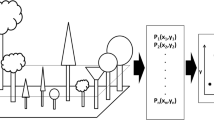Abstract
A complex multivariate spatial point pattern of a plant community with high biodiversity is modelled using a hierarchical multivariate point process model. In the model, interactions between plants with different post-fire regeneration strategies are of key interest. We consider initially a maximum likelihood approach to inference where problems arise due to unknown interaction radii for the plants. We next demonstrate that a Bayesian approach provides a flexible framework for incorporating prior information concerning the interaction radii. From an ecological perspective, we are able both to confirm existing knowledge on species’ interactions and to generate new biological questions and hypotheses on species’ interactions.
Similar content being viewed by others
References
Armstrong P (1991) Species patterning in the heath vegetation of the northern sandplain. Honours thesis, University of Western Australia
Baddeley A, Møller J, Waagepetersen R (2000) Non- and semi-parametric estimation of interaction in inhomogeneous point patterns. Statistica Neerlandica 54: 329–350
Baddeley AJ, Turner R (2005) Spatstat: an R package for analyzing spatial point patterns. J Stat Software 12: 1–42
Barndorff-Nielsen OE (1978) Information and exponential families in statistical theory. Wiley, Chichester
Beard J (1984) Biogeography of the Kwongan. In: Pate J, Beard J (eds) Kwongan – plant life of the sandplains. University of Western Australia Press, Nedlands, pp 1–26
Berman M, Turner R (1992) Approximating point process likelihoods with GLIM. Appl Stat 41: 31–38
Burslem D, Garwood N, Thomas S (2001) Tropical forest diversity – the plot thickens. Science 291: 606–607
Callaway RM (1995) Positive interactions among plants. Bot Rev 61: 306–349
Crawley M (1997) Biodiversity. In: Crawley M (ed) Plant Ecology. Blackwell Publishing, pp 325–358
Dale M, Dixon P, Fortin M, Legendre P, Myers D, Rosenberg M (2002) Conceptional and mathematical relationships among methods for spatial analysis. Ecography 25: 558–577
Diggle P (2003) Statistical analysis of spatial point patterns, 2nd edn. Oxford University Press, Oxford
Durrett R, Levin S (1998) Spatial aspects of interspecific competition. Theor Popul Biol 53: 30–43
Elkington J (1991) Report on the vegetation at Cooljarloo W.A. Unpublished report for TI02 Corporation, Ekomin Pty. Ltd., South Perth
Gelman A, Meng XL, Stern HS (1996) Posterior predictive assessment of model fitness via realized discrepancies (with discussion). Stat Sinica 6: 733–807
Grabarnik P, Särkkä A (2008) Modelling of the spatial structure of a forest stand by Gibbs point processes with hierarchical interactions (in preparation)
Gratzer G, Waagepetersen R, Splechtna BE, Laister M, Coomes D (2008) The influence of seed dispersal and environmental heterogeneity for generation of spatial patterns of seedlings in a spruce beech fir old growth forest (in preparation)
Greig-Smith P (1983) Quantitative plant ecology. Blackwell Scientific, Oxford
Herben T, During H, Law R (2000) Spatio-temporal patterns in grassland communities. In: Dieckmann U, Law R, Metz J(eds) The geometry of ecological interactions: Simplifying spatial complexity. Cambridge University Press, Cambridge, pp 11–27
Högmander H, Särkkä A (1999) Multitype spatial point patterns with hierarchical interactions. Biometrics 55: 1051–1058
Kühlmann-Berenzon S, Heikkinen J, Särkkä A (2005) An additive edge correction for the influence potential of trees. Biometrical J 47: 517–526
Kuuluvainen T, Pukkala T (1889) Effect of scots pine seed trees on the density of ground vegetation and tree seedlings. Silva Fennica 23: 159–167
Law R, Herben T, Dieckmann U (1997) Non-manipulative estimates of competition coefficients in grassland communities. Ecology 85: 505–517
Law R, Murrell D, Dieckmann U (2003) Population growth in space and time: spatial logistic equations. Ecology 84: 252–262
Liebhold A, Gurevitch J (2002) Integrating the statistical analysis of spatial data in ecology. Ecography 25: 553–557
Loreau M, Naeem S, Inchausti P, Bengtsson J, Grime J, Hector A, Hooper D, Huston M, Raffaelli D, Schmid B, Tilman D, Wardle D (2001) Biodiversity and ecosystem functioning: current knowledge and future challenges. Science 294: 804–808
Magurran A (1988) Ecological diversity and its measurement. University Press, Cambridge
Mateu J, Usó J, Montes F (1998) The spatial pattern of a forest ecosystem. Ecol Model 108: 163–174
Miina J, Pukkala T (2002) Application of ecological field theory in distance-dependent growth modelling. Forest Ecol Manag 161: 101–107
Møller J, Waagepetersen R (2003) Statistical inference and simulation for spatial point processes. Chapman and Hall/CRC, Boca Raton
Murrell D, Purves D, Law R (2001) Uniting pattern and process in plant ecology. Trends Ecol Evol 16: 529–530
Økland RH, Rydgren K, Økland T (1999) Single-tree influence on understorey vegetation in Norwegian boreal spruce forest. Oikos 87: 488–498
Richardson D, Cowling R, Lamont B, van Hensbergen H (1995) Coexistence of banksia species in southwestern australia: The role of regional and local processes. J Veg Sci 6: 329–342
Robert CP, Casella G (1999) Monte carlo statistical methods. Springer-Verlag, New York
Schoenberg FP (2005) Consistent parametric estimation of the intensity of a spatial-temporal point process. J Stat Plan Infer 128: 79–93
Stoll P, Weiner J (2000) A neighbourhood view of interactions among individual plants. In: Dieckmann U, Law R, Metz J(eds) The geometry of ecological interactions: simplifying spatial complexity. Cambridge University Press, Cambridge, pp 11–27
Uriarte M, Condit R, Canham C, Hubbell S (2004) A spatially explicit model of sapling growth in a tropical forest: does indentity of neighbours matter. J Ecol 92: 348–360
Waagepetersen R (2005) Posterior propriety for Poisson processes. Manuscript available at http://www.math.aau.dk/~rw+
Waagepetersen R (2007) An estimating function approach to inference for inhomogeneous Neyman-Scott processes. Biometrics 63: 252–258
Wiegand T, Moloney K (2004) Rings, circles, and null-models for point pattern analysis in ecology. Oikos 104: 209–229
Wu H, Sharpe PJH, Walker J, Penridge LK (1985) Ecological field theory: a spatial analysis of resource interference among plants. Ecol Model 29: 215–243
Author information
Authors and Affiliations
Corresponding author
Rights and permissions
About this article
Cite this article
Illian, J.B., Møller, J. & Waagepetersen, R.P. Hierarchical spatial point process analysis for a plant community with high biodiversity. Environ Ecol Stat 16, 389–405 (2009). https://doi.org/10.1007/s10651-007-0070-8
Received:
Revised:
Published:
Issue Date:
DOI: https://doi.org/10.1007/s10651-007-0070-8




